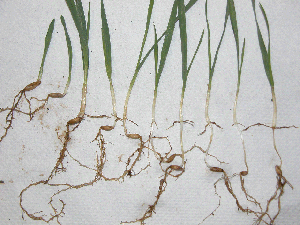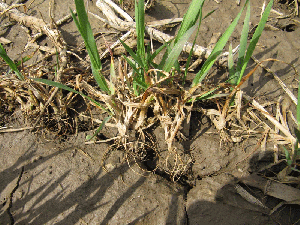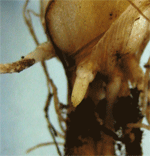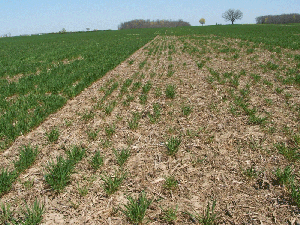Cropside: Dead or alive?
AGRONOMIC INFORMATION FROM ONTARIO'S CROP SPECIALISTS

GET OUT INTO your winter wheat fields and assess the crop in the early spring! Every spring calls come in about wheat going backwards. The reality is you didn’t assess those fields closely enough in early April; the pickup truck slowing down to 60 does not cut it!
It is extremely rare for winters in Ontario to be cold enough to kill wheat. The temperature must drop below -21°C one inch below ground in order for wheat to experience low temperature kill.
What wheat fields experience in Ontario is damage caused by the freeze and thaw cycles that happen in the early spring: frost heave that tears off roots and pushes plants out of the soil.
Examining planting depth impacts
- Note the area between the crown and the seed in Photo 1. This area is known as the mesocotyl. The length of the mesocotyl is a good indication of planting depth.
- Plants 1 and 2 were planted too shallow. The number one reason for frost heave problems is planting too shallow. If you find plants like this in your field this spring, you need to adjust your planting depth next fall.
- Plants 3, 4 and 5 were planted at the ideal depth: a mesocotyl of 1/4 to 3/4 of an inch.
- Plants 6 through 10 were planted too deep. They have less vigour and slow emergence. •
IMPACT OF PLANTING DEPTH:

Frost heave damage
- Plants in Photo 2 demonstrate typical frost heave damage.
- The crown, the growing point of the roots at this stage of development, has been heaved out of the ground. Although the leaves appear green and healthy, these plants will not likely survive. Only frequent rains allowing new roots to penetrate the soil will keep these plants alive, and even then they will be weak and lower yielding.
- To determine if plants like this are alive, look for small, white roots coming out of the crown. The insert in Photo 2 demonstrates this. If there are no new root formations, the plant is no longer alive, despite the deceiving green colour. •
FROST HEAVE DAMAGE:


Assessing the damage
- When determining whether a replant is necessary, it is important to accurately estimate the damage. Growers almost always focus on the bare spots, and thus over-estimate the damage.
- To determine whether it is economical to keep a field, some estimates are helpful. A field should have a minimum of four to seven healthy plants per foot of row in order to keep it. For example, in the poor strip of Photo 3 there are less than two plants per foot of row.
ASSESSING A FIELD:

- Fields are never uniform, and deciding what to do is always a judgment call. When estimating damage, don’t look down the rows: look perpendicular to the rows for a better perspective on damage. Try not to focus on the poor spots, look at the field as a whole. Aerial photographs can be an excellent tool to determine just how much winter kill actually exists. •







